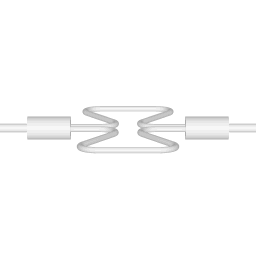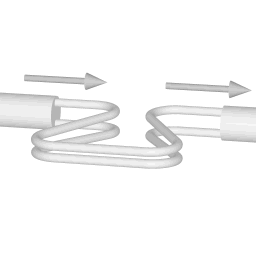Coriolis flow meter
A mass flow meter, also known as inertial flow meter and coriolis flow meter, is a device that measures how much liquid is flowing through a tube. It does not measure the volume of the liquid passing through the tube, it measures the amount of mass flowing through the device.
Volumetric flow rate metering is proportional to mass flow rate only when the density of the fluid is constant. If the fluid has varying density, or contains bubbles, then the volume flow rate multiplied by the density is not an accurate measure of the mass flow rate.
In a mass flow meter the fluid is contained in a smooth tube, with no moving parts that would need to be cleaned and maintained, and that would impede the flow.
Operating principle
There are two basic configurations: the curved tube flow meter and the straight tube flow meter. This article discusses the curved tube design.

Picture 1. animation
A rotating mass flow meter to illustrate the operating principle of the vibrating mass flow meter. |

Picture 2. Animation
When fluid is flowing though the tubes the tubes twist slightly. |
The animations on the right do not represent an actually existing coriolis flow meter design. The purpose of the animations is to illustrate the operating principle, and to show the connection with rotation.
The motion of the fluid relative to the axis of rotation determines what is happening. I will refer to the section of tubing in which the liquid flows away from the axis of rotation as the 'outward arm'. I will refer to the section of tubing in which the liquid flows towards the axis of rotaton again as the 'inward arm'.
During no-flow the outward arm and inward arm remain parallel to each other. The fluid furthest away from the axis of rotation is moving at greater velocity than the "inside track" fluid, but this doesn't require a force in radial direction.
When there is mass flow then in the outward arm fluid is moving away from the axis of rotation, and bringing it up to speed takes some pushing; the arm must exert a force on the fluid, and that makes the arm bend backwards somewhat. The inward arm on the other hand must exert a force on the fluid to decrease its velocity again, hence that arm will bend forwards.
Summerizing: during mass flow the outward arm is lagging behind the overall rotation and the inward arm is somewhat ahead.

The principle design of a curved tube mass flow meter. The vibration pattern during no-flow.
The animation on the right represents how curved tube mass flow meters are designed. The fluid is led through two parallel tubes. An actuator (not shown) induces a vibration of the tubes. The two parallel tubes are counter-vibrating, to make the measuring device less sensitive to outside vibrations. The actual frequency of the vibration depends on the size of the mass flow meter, and ranges from 80 to 1000 vibrations per second. The amplitude of the vibration is too small to be seen, but it can be felt by touch.
When no fluid is flowing, the vibration of the two tubes is symmetrical, as shown in the animation.

Vibration pattern of the tubes during mass flow.
The animation on the right represents what happens during mass flow: there is some twisting of the tubes.
The vibrating mass of the setup doesn't have a constant velocity of course, but we still have that further away from the rotation axis the velocity is larger. The further away from the rotation axis, the larger the energy of the vibration.
The outward arm must exert a force on the fluid to increase vibrational energy, making it lag behind the overall vibration. The inward arm must exert a force on the fluid to decrease the fluid's vibrational energy, hence that arm gets pushed ahead of the overall vibration.
The outward arm and the inward arm vibrate with the same frequency as the overall vibration, but when there is mass flow the two vibrations shift to an out of sync pattern, the outward arm is behind, the inward arm is ahead. The two vibrations are shifted in phase with respect to each other, and the degree of phase-shift is a measure for the amount of mass that is flowing through the tubes.
Major parts of this article have been uploaded by me to The wikipedia article about the mass flow meter.
Wikipeda text is available under the terms of the GNU Free Documentation License

This work is licensed under a Creative Commons Attribution-ShareAlike 3.0 Unported License.
Last time this page was modified: June 18 2017